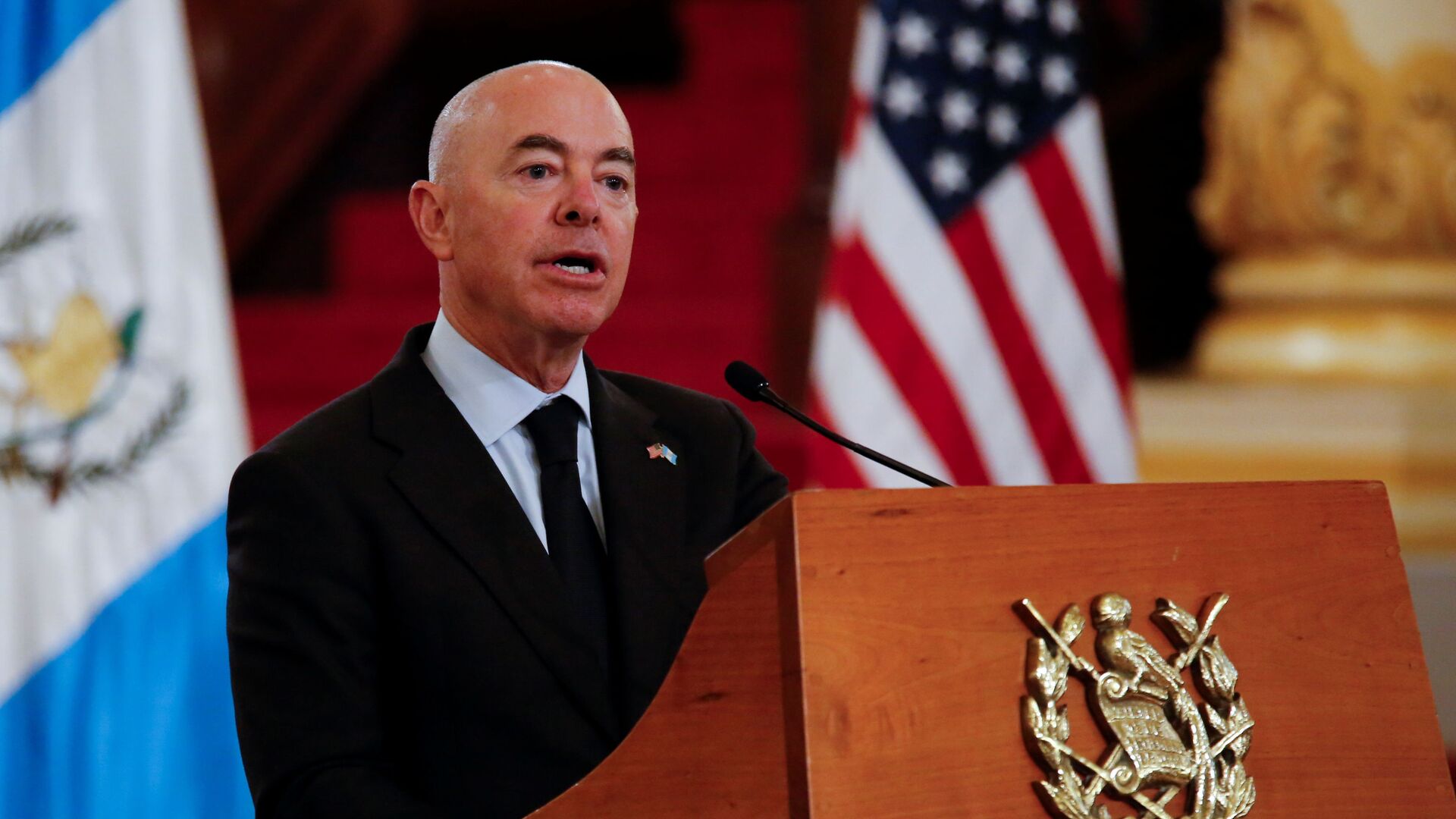https://sputnikglobe.com/20220312/significant-gaps-preventing-us-homeland-securitys-ability-to-detect-domestic-terrorism---report-1093797836.html
'Significant Gaps' Preventing US Homeland Security's Ability to Detect Domestic Terrorism - Report
'Significant Gaps' Preventing US Homeland Security's Ability to Detect Domestic Terrorism - Report
Sputnik International
In the days following the deadly 6 January 2021 attack on Capitol Hill, leaders of the Department of Homeland Security (DHS) created an independent commission... 12.03.2022, Sputnik International
2022-03-12T04:10+0000
2022-03-12T04:10+0000
2022-03-12T04:48+0000
department of homeland security (dhs)
https://cdn1.img.sputnikglobe.com/img/07e5/07/0e/1083383844_0:0:3073:1728_1920x0_80_0_0_eb0a0a9cdfac274ab3960a208d351e66.jpg
Alejandro Mayorkas says the department has "significant gaps" in their attitude towards domestic terrorism. Mayorkas was sworn in as secretary of DHS by US President Joe Biden barely a month after the attack on Capitol Hill.Although the DHS was created to protect "the American people from terrorist threats", the department failed to establish guidelines for what constitutes "domestic terrorism/extremism", as well as how to identify and report an occurrence.The DHS "did not track domestic violent extremism allegations as their own sub-category of misconduct. Instead, such allegations were classified under another sub-category", the internal investigation found. The department's database shows that the first time the department addressed "domestic" violent extremism wasn't until April 2021, when Mayorkas announced a plan to conduct an internal review to address the threat of domestic extremism within the department.Officials within DHS were well aware of the planned attack on Capitol Hill, weeks before the event, and chose to keep that information to themselves. A 50-page report released by the DHS Office of Inspector General on Tuesday details the division within the department's intelligence office, and their failure to disclose information leading up to the 6 January attack.On 21 December 2020, officials in the department's intelligence office circulated information among themselves regarding information relating to an individual who had plans to kill protesters by the dozens, calls to bring weapons to DC, threats of violence against Democrats, law enforcement, and the targeting of specific politicians.Correspondence between two DHS members shows their awareness of threats leading up to the 6 January attack, with one employee texting on 2 January at 8:21 p.m., "Also I found a map of all the exits and entrances to the capitol building. I feel like people are actually going to try and hurt politicians. Jan 6th is gonna be crazy, not to mention the inauguration. Watch us get surged for that lol", the message read.The second employee responded to this message, writing at 8:22 p.m., "Have a feeling as well… days leading up to as well. Some things were going on downtown apparently last night as well. Couple of shoving people around and Proud Boys in the area".Then, at 11:17 p.m., the first employee writes, "Like there's these people talking about hanging Democrats from ropes like wtf". The second employee responds with, "They’d need alot of rope, I think DC is pretty much all democrat haha".According to the Inspector General's report, neither of these employees believed this information warranted an Open Source Infrastructure Report (OSIR). The employees said they were unsure of what language was serious enough to warrant a report, which has been subsequently blamed on a lack of formal training.The DHS employees also blamed their inaction on events of the previous summer, when DHS received heavy criticism for deploying Border Patrol tactical teams to deal with protesters in Portland, Oregon, where protesters were demonstrating in response to the murder of George Floyd. Collectors say they failed to file any reports because they were "affected by the scrutiny they received" that summer.Despite the DHS' apparent mishandling of the 6 January attack, the Office of Inspector General's recommendations appear to be relatively mild in addressing the department's failures. Those recommendations include "enhanced annual training" and reviewing guidelines, as well as implementing policies and procedures on "the timely issuance of warning analysis, both strategic and tactical, about threats or upcoming events across I&A's mission areas".Let's stay in touch no matter what! Follow our Telegram channel to get all the latest news: https://t.me/sputniknewsus
Sputnik International
feedback@sputniknews.com
+74956456601
MIA „Rosiya Segodnya“
2022
Mary Manley
https://cdn1.img.sputnikglobe.com/img/07e6/01/0b/1092187887_0:0:2048:2049_100x100_80_0_0_0c2cc4c84f89aff034cc55bb01fb6697.jpg
Mary Manley
https://cdn1.img.sputnikglobe.com/img/07e6/01/0b/1092187887_0:0:2048:2049_100x100_80_0_0_0c2cc4c84f89aff034cc55bb01fb6697.jpg
News
en_EN
Sputnik International
feedback@sputniknews.com
+74956456601
MIA „Rosiya Segodnya“
Sputnik International
feedback@sputniknews.com
+74956456601
MIA „Rosiya Segodnya“
Mary Manley
https://cdn1.img.sputnikglobe.com/img/07e6/01/0b/1092187887_0:0:2048:2049_100x100_80_0_0_0c2cc4c84f89aff034cc55bb01fb6697.jpg
department of homeland security (dhs)
department of homeland security (dhs)
'Significant Gaps' Preventing US Homeland Security's Ability to Detect Domestic Terrorism - Report
04:10 GMT 12.03.2022 (Updated: 04:48 GMT 12.03.2022) In the days following the deadly 6 January 2021 attack on Capitol Hill, leaders of the Department of Homeland Security (DHS) created an independent commission to investigate the events. That panel was modelled after a commission made to investigate 9/11, and has brought to light the DHS' apparent lack of concern toward domestic terrorism.
Alejandro Mayorkas says the department has "significant gaps" in their attitude towards domestic terrorism. Mayorkas was sworn in as secretary of DHS by US President Joe Biden barely a month after the attack on Capitol
Hill.Although the DHS was created to protect "the American people from terrorist
threats", the department failed to establish guidelines for what
constitutes "domestic terrorism/extremism", as well as how to identify and report an occurrence.
The DHS "did not track domestic violent extremism allegations as their own sub-category of misconduct. Instead, such allegations were classified under another sub-category", the internal investigation
found. The department's database shows that the first time the department addressed "domestic" violent extremism wasn't until April 2021, when Mayorkas
announced a plan to conduct an internal review to address the threat of domestic extremism within the department.
"The Working Group assessed that the department has significant gaps that have impeded its ability to comprehensively prevent, detect, and respond to potential threats related to domestic violent extremism within DHS", the investigative panel announced. "These gaps, which the department is working with urgency to close, may have impacted DHS officials' ability to adequately identify and address related threats", the panel added.
Officials within DHS were well aware of the planned attack on Capitol Hill, weeks before the event, and chose to keep that information to themselves. A 50-page
report released by the DHS Office of Inspector General on Tuesday details the division within the department's intelligence office, and their failure to disclose information leading up to the 6 January attack.
"In the weeks before the events at the U.S. Capitol, I&A identified specific open source threat information related to January 6 but did not issue any intelligence products about these threats until January 8", the report reads. "Additionally, the Counterterrorism Mission Center (CTMC) identified indicators that the January 6 events might turn violent but did not issue an intelligence product outside I&A, even though it had done so for other events".
On 21 December 2020, officials in the department's intelligence office circulated information among themselves regarding information relating to an individual who had plans to kill protesters by the dozens, calls to bring weapons to DC, threats of violence against Democrats, law enforcement, and the targeting of specific
politicians.
Correspondence between two DHS members shows their awareness of threats leading up to the 6 January
attack, with one employee texting on 2 January at 8:21 p.m., "Also I found a map of all the exits and entrances to the capitol building. I feel like people are actually going to try and hurt politicians. Jan 6th is gonna be crazy, not to mention the inauguration. Watch us get surged for that lol", the message read.
The second employee responded to this message, writing at 8:22 p.m., "Have a feeling as well… days leading up to as well. Some things were going on downtown apparently last night as well. Couple of shoving people around and Proud Boys in the area".
Then, at 11:17 p.m., the first employee writes, "Like there's these people talking about hanging Democrats from ropes like wtf". The second employee responds with, "They’d need alot of rope, I think DC is pretty much all democrat haha".
According to the Inspector General's report, neither of these employees believed this information warranted an Open Source Infrastructure Report (OSIR). The employees said they were unsure of what language was serious enough to warrant a report, which has been subsequently blamed on a lack of formal training. "As of January 6, 2021, 16 out of 21 collectors had less than 1 year of experience, and some of these new collectors said they did not receive adequate training to help determine when threat information should be reported", the report stated.
The DHS employees also
blamed their inaction on events of the previous summer, when DHS received heavy criticism for deploying Border Patrol tactical teams to deal with protesters in Portland,
Oregon, where protesters were demonstrating in response to the murder of George Floyd. Collectors say they failed to file any reports because they were "affected by the scrutiny they received" that summer.
Despite the DHS' apparent mishandling of the 6 January attack, the Office of Inspector General's recommendations appear to be relatively mild in addressing the department's failures. Those recommendations include "enhanced annual training" and reviewing guidelines, as well as implementing policies and procedures on "the timely
issuance of warning analysis, both strategic and tactical, about threats or upcoming events across I&A's mission areas".
Let's stay in touch no matter what! Follow our Telegram channel to get all the latest news: https://t.me/sputniknewsus 



